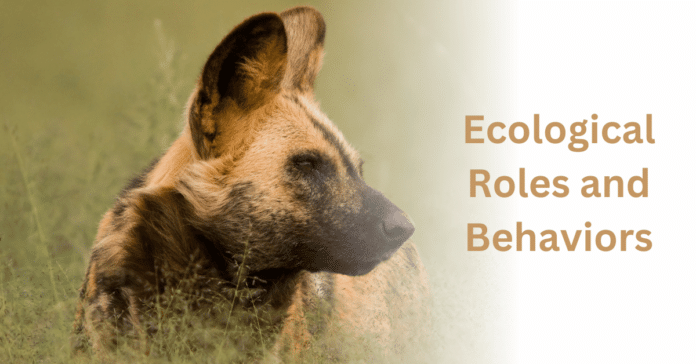Table of Contents
Introduction
African wild dogs, also known as African painted dogs or African hunting dogs, are fascinating and highly social carnivores that inhabit various ecosystems in Africa. These unique canids are known for their cooperative hunting behaviors, intricate social structure, and distinct coat patterns. In this article, we will delve deeper into the ecological roles and behaviors of African wild dogs, exploring their hunting behavior, social structure, habitat and distribution, factors affecting their populations, conservation efforts, and more.
Ecological Roles of African Wild Dogs
African wild dogs are renowned for their remarkable hunting behavior and cooperative hunting strategies. They live and hunt in packs, which can consist of up to 30 individuals, making them one of the most social carnivores in the animal kingdom. Their cooperative hunting involves intricate communication, coordination, and teamwork, with each pack member playing a specific role in the hunt. This cooperative behavior allows them to take down large prey such as antelopes and hares, and their hunting success rate can be as high as 80%. This makes African wild dogs highly effective predators and important ecological regulators in their ecosystems.
Social Behavior of African Wild Dogs
The social structure of African wild dogs revolves around a dominant breeding pair that leads the pack and is responsible for reproduction. Other pack members, which can include males and females of various ages, assist in hunting, pup-rearing, and territorial defense. African wild dogs communicate with each other through vocalizations, body postures, and scent marking. They also exhibit a high degree of cooperation within the pack, with regurgitation and food sharing among pack members, as well as cooperative care of pups by other pack members. This social structure and cooperation within the pack are critical to the survival and success of African wild dogs as highly social animals.
Habitat and Distribution of African Wild Dogs
African wild dogs have a wide distribution across Africa, although their populations have declined and their range has become fragmented due to habitat loss, human-wildlife conflict, and other threats. They prefer a variety of habitats, including savannas, woodlands, and grasslands, and have adapted to living in diverse ecosystems, from arid regions to more humid areas. Their ability to adapt to different habitats is a testament to their ecological resilience as a species.
Factors Affecting African Wild Dog Populations
African wild dogs face numerous threats to their populations, including habitat loss and fragmentation, human-wildlife conflict, disease, and climate change. Habitat loss due to agriculture, mining, and infrastructure development has resulted in shrinking and fragmented wild dog populations. Human-wildlife conflict arises from competition for resources with local communities, as well as persecution due to perceived threats to livestock or human safety. African wild dogs are also susceptible to diseases and parasitism, including rabies, distemper, and tick-borne diseases, which can significantly impact their populations. Additionally, climate change poses threats to their habitats, with changing rainfall patterns and temperatures affecting their food availability and distribution.
Conservation Efforts for African Wild Dogs
Conservation efforts are underway to protect and conserve African wild dogs. These efforts include habitat conservation, protected area management, community-based conservation programs, and education and outreach. Conservation organizations and governments work to establish and manage protected areas where wild dogs can thrive, as well as implement conservation strategies that involve local communities in the conservation efforts. Research and monitoring are also critical to understand the population dynamics, ecology, and behavior of African wild dogs to inform conservation strategies. Education and outreach programs help raise awareness about the importance of African wild dogs and their conservation needs among local communities, tourists, and the general public.
Conclusion
African wild dogs are extraordinary creatures that play a vital ecological role in African ecosystems. Their cooperative hunting behavior, social structure, and adaptability to diverse habitats make them fascinating subjects of study and conservation efforts. By understanding and conserving these unique animals, we can contribute to the preservation of Africa’s biodiversity and ensure a brighter future for African wild dogs and the ecosystems they inhabit. Let’s continue to appreciate and protect these captivating carnivores for generations to come.
FAQs
Q: What are African wild dogs?
A: African wild dogs, also known as African painted dogs or Cape hunting dogs, are a species of large carnivorous mammals native to Africa. They are known for their distinctive coat pattern, with patches of black, white, and tan fur, and their highly social behavior.
Q: Where do African wild dogs live?
A: African wild dogs can be found in various habitats across Africa, including savannas, grasslands, woodlands, and deserts. They are most commonly found in eastern and southern Africa, including countries such as Botswana, Zimbabwe, Tanzania, and South Africa.
Q: What is the behavior of African wild dogs?
A: African wild dogs are highly social animals that live in packs. They have a complex social structure, with a dominant breeding pair and other subordinate members. They are known for their cooperative hunting behavior, where they work together as a team to chase and catch their prey. They communicate through vocalizations, body postures, and scent marking.
Q: What do African wild dogs eat?
A: African wild dogs primarily feed on medium-sized antelope species, such as impala, gazelles, and springbok. They are also known to hunt smaller mammals, birds, and insects. Their diet is mainly composed of meat, and they are highly specialized and efficient hunters.
Q: What are the threats to African wild dogs?
A: African wild dogs face numerous threats, including habitat loss, fragmentation, and degradation due to human activities such as agriculture, mining, and infrastructure development. They are also vulnerable to diseases transmitted by domestic dogs, as well as human-wildlife conflict, including persecution by farmers and hunters.
Q: How can African wild dogs be conserved?
A: Conservation efforts for African wild dogs include protecting their habitats, managing protected areas effectively, engaging local communities in conservation initiatives, and raising awareness about their ecological importance. Research and monitoring efforts are also crucial for better understanding their behavior, ecology, and population dynamics to inform conservation strategies.
Q: Are African wild dogs endangered?
A: Yes, African wild dogs are listed as Endangered on the IUCN Red List of Threatened Species. Their populations have declined significantly over the past decades, and their conservation status is at risk due to habitat loss, human-wildlife conflict, and other threats.
Q: How can I help African wild dogs?
A: There are several ways to help African wild dogs, including supporting reputable conservation organizations working on their conservation, spreading awareness about their plight, and advocating for policies and actions that protect their habitats and ensure their survival. Donations, volunteering, and ecotourism can also be meaningful ways to contribute to their conservation efforts.
































